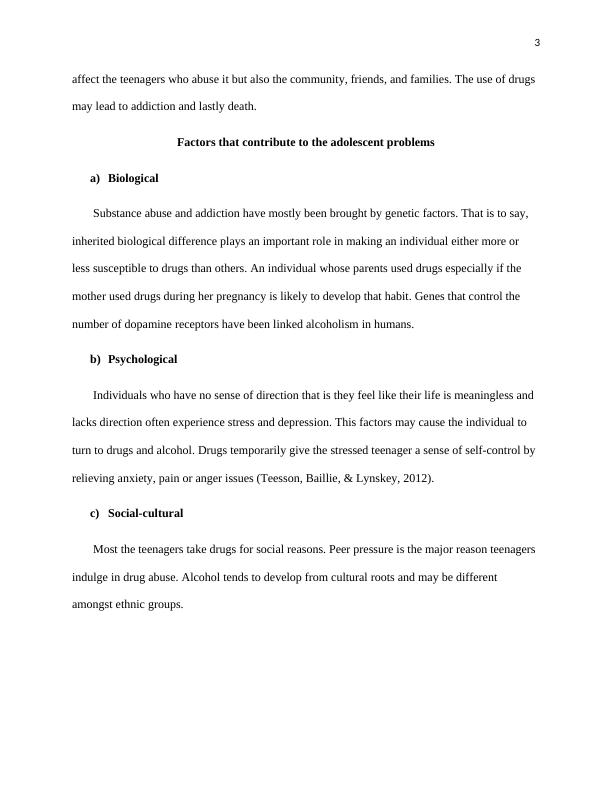Adolescence: Issues, Factors, and Interventions
Added on 2023-05-28
6 Pages1223 Words215 Views
Running header: ADOLESCENCE 1
Adolescence
Student’s name
Institutional
Adolescence
Student’s name
Institutional

2
Introduction
In human development, adolescence is one of the most rapid phases occurring at ages thirteen
to nineteen. It is as a transitional stage from childhood to adulthood. The changes during
development may bring confusion in an individual on issues of independence and self-identity,
many of the adolescents may experience difficult decision regarding sexuality, social life, school
and lastly drugs and alcohol (Bareimon & Carl, 2014). The objectives discussed in this essay
include recognizing the important issues facing adolescents today, the socio-cultural,
psychological and biological factors that add to adolescent problems, and lastly interventions that
help promote positive development.
The major issue facing adolescents today
The major problem faced by teenagers between age thirteen and nineteen years old is drugs
and alcohol abuse. During this phase, teens are subjected to some internal and external struggles
which include puberty, hormonal changes, parental force, social and school pressures. These
struggles expose the individuals to stress and depression forcing them to turn to drugs and
alcohol as form escapism.
Annual survey indicates that marijuana is the most popular used drug among teenagers and
young adults in the United States. It is used by 14.8 million people in the US. The drug use
health data pointed out 46% of adolescents of age 12 years and above in the US have tried illicit
drugs at least once in a lifetime, 40.6% have used marijuana, and the other 29.7% have used
illicit drugs. Drugs and alcohol abuse is an important issue to be discussed in society when
considering adolescent, for the reason that it is a threat to society. Drug abuse not only does it
Introduction
In human development, adolescence is one of the most rapid phases occurring at ages thirteen
to nineteen. It is as a transitional stage from childhood to adulthood. The changes during
development may bring confusion in an individual on issues of independence and self-identity,
many of the adolescents may experience difficult decision regarding sexuality, social life, school
and lastly drugs and alcohol (Bareimon & Carl, 2014). The objectives discussed in this essay
include recognizing the important issues facing adolescents today, the socio-cultural,
psychological and biological factors that add to adolescent problems, and lastly interventions that
help promote positive development.
The major issue facing adolescents today
The major problem faced by teenagers between age thirteen and nineteen years old is drugs
and alcohol abuse. During this phase, teens are subjected to some internal and external struggles
which include puberty, hormonal changes, parental force, social and school pressures. These
struggles expose the individuals to stress and depression forcing them to turn to drugs and
alcohol as form escapism.
Annual survey indicates that marijuana is the most popular used drug among teenagers and
young adults in the United States. It is used by 14.8 million people in the US. The drug use
health data pointed out 46% of adolescents of age 12 years and above in the US have tried illicit
drugs at least once in a lifetime, 40.6% have used marijuana, and the other 29.7% have used
illicit drugs. Drugs and alcohol abuse is an important issue to be discussed in society when
considering adolescent, for the reason that it is a threat to society. Drug abuse not only does it

3
affect the teenagers who abuse it but also the community, friends, and families. The use of drugs
may lead to addiction and lastly death.
Factors that contribute to the adolescent problems
a) Biological
Substance abuse and addiction have mostly been brought by genetic factors. That is to say,
inherited biological difference plays an important role in making an individual either more or
less susceptible to drugs than others. An individual whose parents used drugs especially if the
mother used drugs during her pregnancy is likely to develop that habit. Genes that control the
number of dopamine receptors have been linked alcoholism in humans.
b) Psychological
Individuals who have no sense of direction that is they feel like their life is meaningless and
lacks direction often experience stress and depression. This factors may cause the individual to
turn to drugs and alcohol. Drugs temporarily give the stressed teenager a sense of self-control by
relieving anxiety, pain or anger issues (Teesson, Baillie, & Lynskey, 2012).
c) Social-cultural
Most the teenagers take drugs for social reasons. Peer pressure is the major reason teenagers
indulge in drug abuse. Alcohol tends to develop from cultural roots and may be different
amongst ethnic groups.
affect the teenagers who abuse it but also the community, friends, and families. The use of drugs
may lead to addiction and lastly death.
Factors that contribute to the adolescent problems
a) Biological
Substance abuse and addiction have mostly been brought by genetic factors. That is to say,
inherited biological difference plays an important role in making an individual either more or
less susceptible to drugs than others. An individual whose parents used drugs especially if the
mother used drugs during her pregnancy is likely to develop that habit. Genes that control the
number of dopamine receptors have been linked alcoholism in humans.
b) Psychological
Individuals who have no sense of direction that is they feel like their life is meaningless and
lacks direction often experience stress and depression. This factors may cause the individual to
turn to drugs and alcohol. Drugs temporarily give the stressed teenager a sense of self-control by
relieving anxiety, pain or anger issues (Teesson, Baillie, & Lynskey, 2012).
c) Social-cultural
Most the teenagers take drugs for social reasons. Peer pressure is the major reason teenagers
indulge in drug abuse. Alcohol tends to develop from cultural roots and may be different
amongst ethnic groups.

End of preview
Want to access all the pages? Upload your documents or become a member.
Related Documents
Assignment on Addiction in Teenagerslg...
|12
|1994
|22
Substance Abuse Among Young People in Australialg...
|16
|4855
|95
Psychologylg...
|7
|1571
|57
Contemporary Teenage Issueslg...
|7
|1370
|53
Analysis of Peer-Based Approaches in Addiction Treatmentlg...
|7
|1400
|387
Cannabis Abuse in Teenagers: Impaired Growth and Developmentlg...
|14
|4013
|172
